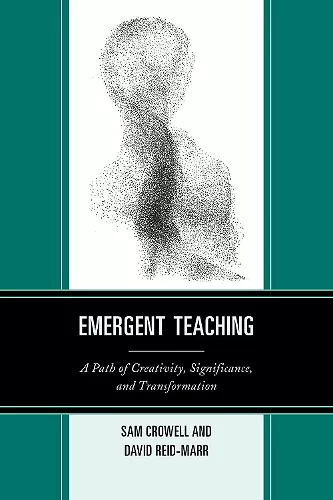Emergent Teaching
A Path of Creativity, Significance, and Transformation
Sam Crowell author David Reid-Marr author
Format:Hardback
Publisher:Rowman & Littlefield
Published:10th Jan '13
Currently unavailable, and unfortunately no date known when it will be back
This hardback is available in another edition too:
- Paperback£35.00(9781475802559)

Emergent Teaching inspires teachers to teach with more spontaneity and creativity within an educational environment that is highly constrained. It demonstrates, through descriptive stories, creative strategies and provides an intellectual foundation for emergent teaching. The authors show how teachers can relate subject matter to students’ lives and experience. They illustrate rituals and processes that help establish a caring learning community. Finally, the book applies the theories of complexity and chaos while reaffirming the natural wisdom that teachers possess within themselves. The authors have chosen a narrative format that “models” rather than “tells,” and encourages readers to connect to their own stories and experiences. The book is consistent with the theoretical understandings and research in the complexity sciences but takes a narrative approach, giving examples and illustrations of ideas through stories, myths, and parables that act as metaphors and illustrations. Key topics and practices embedded in these stories include: ·teaching the whole person ·strategies for creative teaching ·new understandings of process ·meaning-centered learning ·building community in the classroom ·strengthening the student/teacher relationship ·project-based learning ·using art and nature in teaching ·embodied learning ·incorporating story and narrative in teaching ·rites of passage ·embracing the unpredictable, uncharted spaces in teaching
As states adopt common core standards and school districts ponder scripted curriculum that allegedly ensures that such standards are met, some classroom teachers have sought alternate routes. Emergent Teaching results from teachers' understanding that they can influence but cannot control what occurs in the classroom. Instead, Crowell and Reid-Marr assert that although teachers may anticipate certain patterns, classroom practice largely involves assisting learners to discover personal significance and creating a sense of belonging. Organized into ten chapters, the book defines emergent teaching and then examines some central tenets of the approach, including the experience of non-separation, event-centric teaching, non-linear instruction, the emergence of understanding, and the roles of play and joy in the classroom. Within these contexts, Crowell and Reid-Marr explore how teachers may encourage creativity, build relevance, and link emergence to the curriculum and other holistic concerns. Clearly written and full of useful examples of emergent teaching in action, the book is a great complement to A. S. Neill and Albert Lamb's Summerhill School (1994) or Maxine Greene's Releasing the Imagination. Summing Up: Highly recommended. All readership levels. * CHOICE *
Crowell and Reid- Marr present accessible conversations, reflections and stories that guide the reader through a transdisciplinary approach to teaching. Teachers are offered strategies for emergent teaching that can transform their learning worlds. . . .This work affirms and advances our understanding of transformative education. By interweaving the new sciences, the importance of non-linearity, process, and creativity, Crowell and Reid-Marr offer a significant responsive holistic approach to education that addresses the whole person. . . .The clear style and easily understood ideas make the book suitable for a wide audience, from undergraduates to academics and extends our perspectives to implement transformative learning theory into educational practice. Crowell and Reid- Marr embody and model what it means to be spiritual, mindful, inclusive, creative, critical, and collaborative. * Journal of Transformative Learning *
This book is a conversation, a curriculum conversation among Sam, an educator with an interest in the new sciences, holistic education, and spirituality, and David, a trained artist and ordained Zen monk, and the students they have worked with and learned from over the years. From these conversations emerge creative insights into teaching, learning, living. Reading this book will transform one’s own insights into all three. -- Wm. Doll, Univ. of British Columbia, Co-Founder of AERA, Chaos and Complexity SIG
In a universe increasingly shown to be radically interconnected and dynamic, education has largely remained disconnected and plodding. Drawing from the 'new sciences' and extensive teaching encounters, Emergent Teaching provides a philosophically astute and eminently practical hope for teaching as holistic, structured improvisation. This nuanced, wise, and intimate work, punctuated with compelling first-hand accounts of transformative teaching, serves as a potent invitation into what vibrant teaching can be. -- Tobin Hart, Professor of Psychology, Author of: The Secret Spiritual World of Children and From Information to Transformation: Education for the Evolution of Consciousness
The concepts of emergent curriculum and emergent teaching have been around for years but have remained elusive. Crowell and Reid-Marr's book at last brings clarity to emergent teaching in manner that teachers will find helpful. The book is filled with stories and vignettes that bring emergent teaching to life. The ideas presented are linked to the new sciences so that underlying the practices that are described is a strong theoretical base. This book is a very welcome addition to the literature on holistic education. -- Dr. Jack Miller, professor of curriculum, teaching, and learning, University of Toronto; author of The Holistic Curriculum
Many educators have referred to teaching as an art, very few have actually penetrated that question, let alone show what such teaching looks like in practice. Emergent Teaching: A Path of Creativity, Significance, and Transformation treats this topic with a clarity born of a deep understanding of systems thinking and process, one that continuously allows the original insights of their students to emerge. This book succeeds both in articulating the theory and showing how to radically enrich education. -- Renate and Geoffrey Caine, authors of: Natural Learning for a Connected World: Education, Technology, and the Human Brain (2011, Teacher College Press), Strengthening and Enriching your Professional Learning Community: The Art of Learning Together (ASCD, 2010)
ISBN: 9781475802542
Dimensions: 236mm x 158mm x 18mm
Weight: 386g
168 pages